The meaning of customer loyalty is changing in 2023
Don't get left behind - learn how to create innovative loyalty programs and customer loyalty management strategies to stay ahead of the curve.
Customer loyalty is crucial for businesses as repeat clients contribute significantly to the brand’s revenue and reputation. Investing in solid relationships with them increases retention rates, overall profits, and client trust. Loyalty also generates valuable first-party data for marketing optimization. However, building customer loyalty is challenging due to competition, market dynamics, and evolving loyalty trends. Understand this concept to unlock the path to success.
Ready to dive into it? Let’s start from the basics.
[ Table Of Contents ]
- What is Customer Loyalty?
- 5 Types of Loyal Customers
- Why is Customer Loyalty Important?
- Benefits of Customer Loyalty
- How to Build Customer Loyalty?
- Customer Loyalty vs. CRM
- 10 Effective Customer Loyalty Strategies
- Best Customer Loyalty Programs Examples
- How to Create a Customer Loyalty Program?
- How to Increase Customer Loyalty?
- How to Measure Customer Loyalty?
- Challenges of Building Customer Loyalty
75% of customers say they’re more likely to be loyal to brands that understand them on a personal level.
On the other hand, though, it takes just one bad experience with a product or service to make 50% of customers switch to a competitor .
What is
Customer Loyalty?
Customer loyalty is an ongoing, mutually beneficial relationship between a brand and its customer, in which the latter repeatedly chooses the brand’s services over other companies on the market. What makes customers loyal is a combination of many different – sometimes hard to measure – factors.
The key, however, is always a meaningful experience.
Regardless of how you define customer loyalty, clients choose brands they remember as worth investing in. Be it through product standards, great pricing, customer service, or even shared values – it’s the experience that drives clients to return. When clients are happy, they are more likely to engage with your marketing channels, bring attention to new promotions, and recommend your brand to their friends and family.
5 Types of Loyal Customers
Customers have different reasons to be loyal to a brand. Some find price determining, while others prefer to look at the benefits.
Here are the most important critical types of loyal customers :
- Satisfied-loyal: These are basically happy customers. They like your products or services, and just for that reason, they will keep purchasing in your stores. It is important to take care of them, as they are likely to be easily swayed by your competitor’s value.
- Convenience-loyal: This type of customer chooses your brand because it is convenient. They have stores close to them, buying online is fast and comfortable, they can communicate easily with your customer service, etc.
- Price-loyal: These customers purchase with you because of the low prices . They appreciate big significant discounts, free shipping, and free gifts as a part of the customer value proposition. Nevertheless, they will go with someone else if the deal is better. Money will always come first.
- Loyalty program-loyal: This type of customer stays with your brand due to benefits from your loyalty program and its benefits . They like the value they get by purchasing with you. That’s why rewarding loyal customers and keeping your loyalty program alive is so importantit’s so important to reward loyal customers and keep your loyalty program alive.
- Truly loyal: These customers are your best friends. They aren’t likely to leave you for another competitor. They will be actively involved with your initiatives, purchasing, providing feedback, and referring your products or services to their friends. These loyal consumers are real natural advocates of your brand.
While truly loyal customers may sound like the ideal type to cultivate around your brand, certain business models may benefit more from focusing on other customer types. For instance, grocery stores, pharmacies, and gas stations may find value in customers who exhibit loyalty based on convenience. By offering essential products or services, these businesses can attract and retain clients who prioritize efficiency in their purchasing decisions.
It's also important to note that price-loyal customers have the potential to evolve into truly loyal customers through your proactive efforts. By analyzing your customer base and adapting to changes, you can effectively respond to their changing needs and preferences.
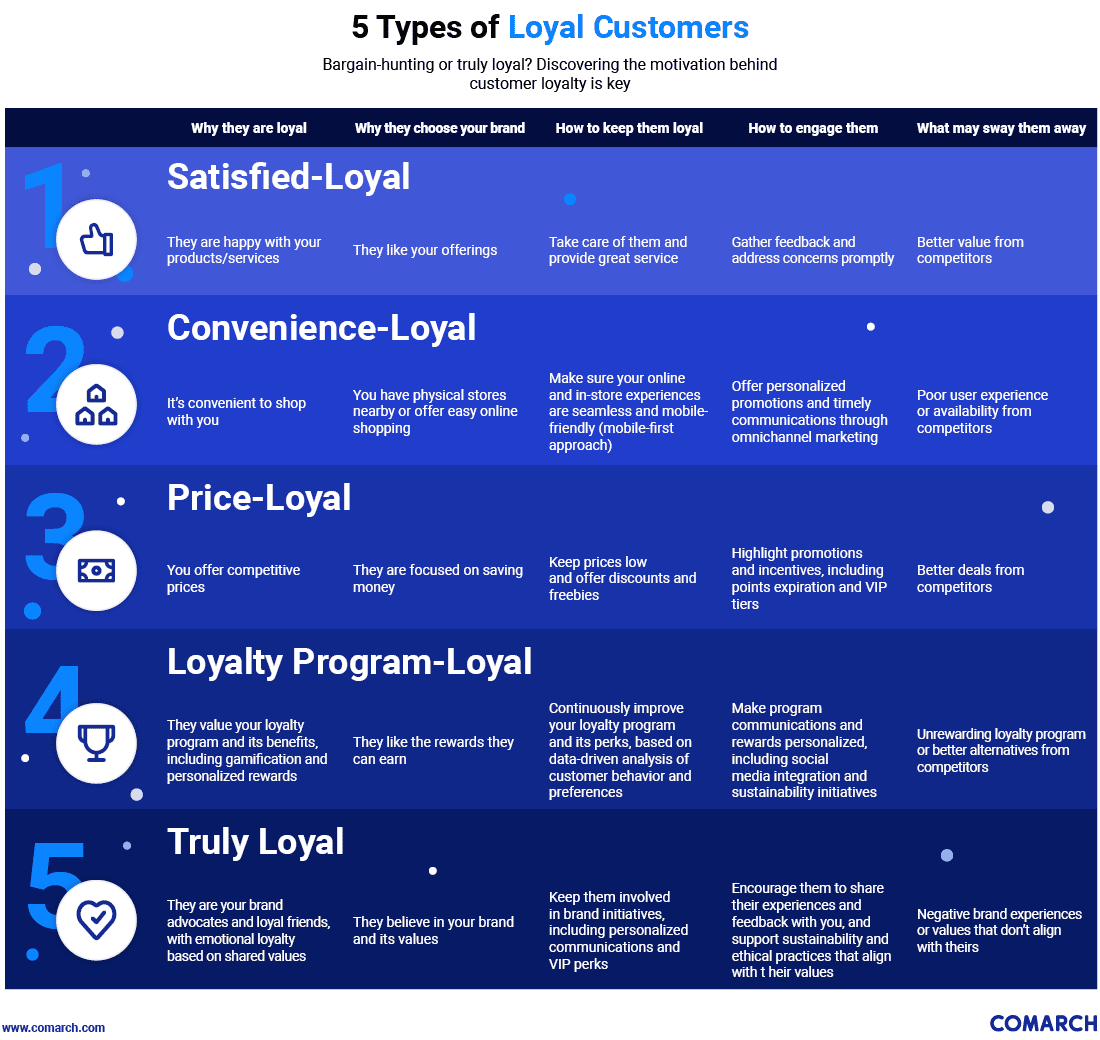
Why is
Customer Loyalty Important?
The importance of customer loyalty comes down to numbers. To put it simply, having loyal yields financial benefits. That’s because they usually spend more money on your business, have a much higher chance of converting, and it takes less effort to maintain them than it does to obtain new ones.
As Pareto’s principles state, 20% of your customers provide 80% of the value. While acquiring more new customers and clients is obviously relevant for your business growth, focusing on a customer retention strategy will bring the most significant profit to your company with the least effort required. That’s because the top 10% of your customer base is spending 3x more than your average customer due to repeat purchases. The most loyal customers are those with experience and knowledge of your brand, therefore, they will be more eager to trust your products and services.
Benefits of Customer Loyalty
Lower costs: It is easier, and consequently cheaper, to keep a customer rather than recruit a new one. It is approximately five times more expensive to acquire new clients. As a result, a retention strategy will allow your company to dedicate more resources to other initiatives.
Profits boosts: Studies have proven that increasing customer retention just by 5% can increase profits up to 95%.
Higher spending: Satisfied customers that already know your brand and its value are easier to sell to. Repeat customers tend to make higher-value purchases and shop more frequently.
- Higher engagement: Engaged customers not only repeat purchases but also provide feedback, participate in loyalty programs, refer friends or family, and even become brand advocates. Interactions like these increase customer lifetime value and ultimately help you refine your offerings.
Gaining brand ambassadors: Your loyal customer is the best person to talk to about your brand. One of the main goals of your customer loyalty strategy should be turning your loyal consumers into brand ambassadors. They will recommend your program, products, and services to their friends and family, growing your customer base through word-of-mouth marketing.
Increased empathy: A good long-term relationship develops empathy and understanding. This means that loyal customers will have a higher tolerance for mistakes and will forgive the brand if anything goes wrong. They know that excellent customer service, product quality, and overall experience will ultimately be worth it.
Better reputation: If you reward loyal customers, they will speak highly of your brand, resulting in reduced complaints and better optics.
How to
Build Customer Loyalty?
To build true customer loyalty, you need to analyze your audience, understand their needs and create a loyalty strategy that fulfills them. You must address questions like: What are your customers looking for in your brand? What distinguishes your brand from the competition? How can your company satisfy your client’s needs?
One of the best ways to find out what your consumers want and their buying habits is to listen to what they have to say. It may sound obvious, but sometimes we forget about it. To build trust, we need stronger customer relationships. There are multiple ways to collect direct information, such as product and service feedback, reviews, or surveys. This data will allow you to personalize your communication and target your audience most efficiently. Also, it will help build the best shopping experience – both in-store and online.
How do you gather this information? By building a highly effective loyalty program. It’s a great way to not only collect but also leverage this data. And it’s the best mechanism to reward your consumers for staying with you. A good rewards system may be crucial for their satisfaction and will make them see that being loyal to you pays off.

Customer Loyalty vs. CRM - What is the Difference
When building a customer loyalty strategy, it is common to confuse customer loyalty with CRM (Customer Relationship Management). While both play a pivotal role in the customer journey, it is essential to remember the key differences that set them apart:
- CRM is the technology to manage the relationships of the company with its existing customer and potential customers. It collects and organizes the customers’ data, helps evaluate and influence customers’ behavior, and improves their experience.
- Customer loyalty is only focused on existing customers and their retention. Gaining customer loyalty or joining a loyalty program to encourage customers could be some of the goals of a CRM strategy.
In terms of similarities, both customer loyalty programs and CRM support automation, personalization, and the creation of unique customer experiences. However, the communication in a loyalty program is more precise, relevant, and personalized compared to CRM. While loyalty programs may require more from your clients, they also deliver more value in return from your brand.
That is also why CRM collects basic forms of information valuable customers – e.g., name, email, and contact number – while customer loyalty will be looking for a greater number of data points – e.g., money spent, closest store, and favorite product.
In addition to the standard customer touchpoints, loyalty programs will also be integrated with the POS systems, where communications will be sent to the customers in real time. The CRM tool will be generally limited to traditional channels with a special focus on email campaigns.
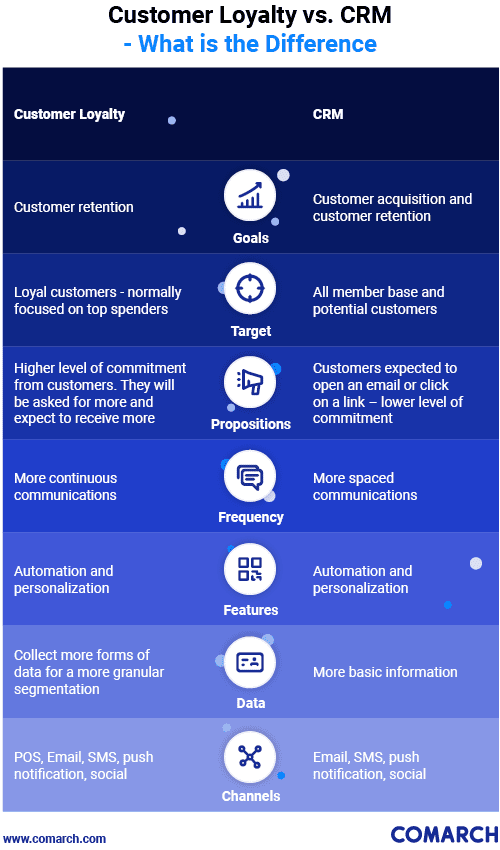
10 Effective Customer Loyalty Strategies
Now that we know what customer loyalty is, we can enumerate some of the strategies that will entice consumers and encourage them to purchase more and more often for repeat business.
Points-based Program: Creating a points-based program where members can accumulate points is a great way to incentivize them. The value of loyalty points will be perceived and exchanged for rewards, discounts, or coupons. They can even be donated to charity.
Intuitive Touchpoints: To efficiently record each member’s transactions and more, it’s beneficial to provide convenient touchpoints for customers, such as cards or mobile apps, which can be scanned during purchases.
Segmentation: Dividing your member base into different groups and defining your customer segmentation models based on demographic, psychographic, and behavioral characteristics is the most efficient way to target them with personalized messages that will increase your conversion rate.
Levels or Tiers: One of the best ways to make your customers feel special is by giving them exclusive benefits. This can be done through recognition tiers. The higher the tier, the better the perks. If these benefits are worth it, your clients will never want to leave the tier that grants them a higher status.
Gamification: Including different games can directly influence your members, enhancing customer engagement. Leaderboards, badges, and special points can become a powerful gamification engine.
Refer a Friend: There is no one we trust more than our closest family and friends. That is why one of the best strategies for maintaining customer loyalty is a referral rewards program to reward your existing members for sharing your brand with others.
Rewards: More than 50% of customers say their primary reason for joining a loyalty program is to earn rewards on everyday purchases. These can go from physical prizes like electronics and merchandising to experiences, gift cards, or cash back.
Coupons and Discounts: Coupons and discounts can be part of the catalog or can be granted as part of a promotion. For example – you can give a 15% discount coupon on your client’s birthday. These will incentivize your customers to keep spending right away.
Partnerships: allowing your customers to earn and burn points through different companies helps increase your loyalty strategy proposition.
Feedback: To better understand how your customers feel about your brand, it is best to frequently ask for their feedback. This will show you what you need to work on to improve their experience.
The Best Customer Loyalty Programs Examples
The most effective customer loyalty programs include a very strong emotional engagement, high levels of personalization, robust rewards systems, and feelings of exclusivity. Additionally, the design of each program should be tailored to fit the specific industry and cater to the target audience.
Here are some examples of the best customer loyalty programs currently on the market:
Amazon
One of the main goals of Amazon founder, Jeff Bezos, is to have the “most customer-centric company on Earth.” That is why Amazon prioritized caring for existing customers versus acquiring new ones. With a yearly subscription, two-day free shipping, and Prime Video, Amazon has reached the top consumers who spend almost double that of regular members.
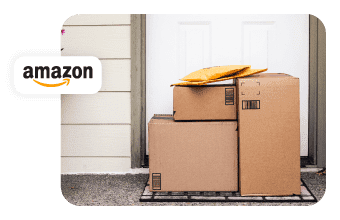

Nike
Nike’s loyalty program is accessible through its website or any of its apps. They offer members exclusive access to sales, rewards, products, and personalized recommendations. The brand also promotes a sense of community where you can access experts' advice, free workout classes, and training content. Nike always tries to connect with their customers on a more emotional level.
Starbucks
Starbucks has one of the most successful loyalty programs. Customers earn stars for each purchase that they can redeem for products. The coffee brand allows to upload credit into the app, buy from the phone and pick up in the closest store. Starbucks also focuses on building important partnerships – as they did with Spotify. The music-streaming brand grew its subscriber base with a Starbucks incentive that earned members rewards such as free coffee. At the same time, Starbucks provided premiere coffee-shop music, incentivizing Spotify users to join their customer loyalty program.
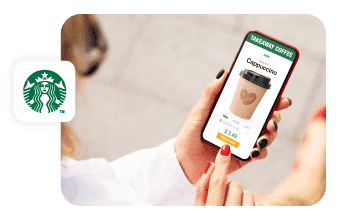
Enterprise Plus
Enterprise rewards program gives points for the money their clients spend. These points can be redeemed for free rental days. The rental car company operates on simplicity – they offer a very basic yet powerful experience, as well as easy program enrolment.

How to Create
a Customer Loyalty Program?
To create a customer loyalty program, you need to prepare a very thorough overview of your goals, resources, and client base. Then you can move on to specific components, characteristics, and tools your program will have – as well as choosing the right customer loyalty marketing solution provider.
How to get started? Here are the most important steps to help you build a loyalty program:
1. Define your objectives
Organizations should clearly establish the goals of their program early in the project. These objectives can include increased engagement, customer retention, or repeat purchases. It’s crucial to align the program’s objectives with your business’s broader goals and vision. If market positioning or product differentiation is a primary goal, it will guide the creation of a loyalty program that effectively achieves those aims.
2. Know your audience
Understanding your customers is crucial for motivating them in the future. Analyze your target audience, their needs, and their perspectives. The customer experience team should determine what data to collect at multiple touchpoints. Gathering this data will give you insights into what fosters loyalty within your organization.
3. Design the program structure
Incentivizing existing customers can be achieved through various methods, such as discounts, money returns, or free products. The key is to choose the most suitable option for your audience. With this in mind, you can select the right type of loyalty program. Here are some examples:
- Points-based programs reward customers for repeat purchases, referrals, and other operations.
- Tiered loyalty programs offer different benefits based on customer spending.
- Value-based loyalty programs showcase your company’s values while enabling clients to donate to specific causes.
- Gamified programs keep customers engaged with the brand.
4. Implement data collection
Systematic data gathering leads to valuable insights, informed decisions, and program performance optimization. Determine the type of data that should be collected through registration forms and purchase history, and establish a CRM for efficient data management. Ensure that the data of your customers is secure and that the loyalty program complies with local data processing policies, such as GDPR or CCPA.
5. Personalize your program
Once you have chosen the appropriate type of loyalty program, you can determine tiers, rewards, and achievable milestones for your customers. Utilize customer data to create a more relevant experience. For example, consider using purchase history or demographics to offer rewards that align with the interests of individual customers. Targeted communication and an omnichannel approach will help build a stronger connection with your brand.
Personalizing the customer experience can be as simple as allowing members to select preferred reward options, customize interface layouts, or choose their preferred touchpoints.
6. Evaluate the effectiveness and adapt
Implement measurements of success for your loyalty program, such as key performance indicators (KPIs), including:
- Customer Retention Rate
- Average Spend per Member
- Customer Lifetime Value
- Referral Rate.
These metrics will allow you to make data-driven adjustments and improvements after the program’s launch. Utilizing KPIs and data analysis tools helps your company track the success of the strategies implemented to achieve your goals.
7. Communicate and solicit feedback
Creating a truly successful customer loyalty program doesn’t end with its launch. It is essential to maintain communication with your clients through channels such as live chat, email campaigns, or regular surveys. Gathering customer feedback will help you further improve your program and build a positive brand image that continually adapts to meet customer needs.
How to
Increase Customer Loyalty?
Building customer loyalty is possible through a profound understanding of your client base, robust personalization, and creating a feeling of value. Loyalty programs are great tools to achieve these results. Here’s how to make more people interested in them:
- Good visibility on your site: Your program needs to have good visibility and be easy to access for your customers. It needs to capture their attention.
- Easy enrolment: Once your clients decide to join your program, they need to know what to do next. Adding the essential required field, plus terms and conditions, will make their enrolment more agile.
- Speak their language: Once you know your audience better, create messages and communications according to your customers’ preferences and needs. The more personalized content directed at your clients, the better the chance your message will get through to them. Not only will this affect their activities more profoundly, but it will also make them feel understood, which can pave the way for closer and longer-lasting customer relationships.
- Flexible payment: Giving a flexible choice of payment methods will facilitate the purchase process for your customers.
- Omnichannel communications: To increase customer engagement you should be where your customers are. Use different traditional channels – email, SMS, a push notification – and social media to communicate with your members and deliver your promotions and offers. Marketing Automation tools will help you reach your audience with the right message at the right time thanks to send time optimization features.
- Customer service: Your customers want to be listened to and helped if needed. Providing excellent customer service will significantly impact loyalty.
- Ask for help: There are plenty of loyalty experts around, so do not hesitate to ask for help when things are not going right. Loyalty consultants and strategy experts will broaden your point of view and help you find different solutions to your challenges.
71% of consumers expect companies to deliver personalized interactions and 76% get frustrated when this doesn’t happen.
How to Measure Customer Loyalty
Customer loyalty metrics include triggered promotions, issued points, and redeemed rewards. There are many factors and variables at play, so you need to implement a very good tracking system to quickly collect customer loyalty statistics.
What are some other KPIs that prove your program is working? Here are indicators you can use when measuring customer loyalty:
- Customer Lifetime Value (CLV): This is one of the most important customer loyalty metrics. It estimates the profit that each customer will generate for your company over the period they are customers. An increased CLV reflects higher revenue, customer satisfaction, and a reduction in acquisition costs.
- Customer Retention Rate (CRR): This statistic compares the percentage of customers a company retains in a specific period with the percentage of customers the company loses. The good news is that there are different strategies to win back lost customers.
- Churn Rate (CR): This metric represents the percentage of customers that stopped purchasing with you or stopped using your services over a given period.
- Net Promoter Score (NPS): The Net Promoter Score predicts how likely a customer is to recommend your brand to a friend. It measures trust and customer satisfaction in a long-term relationship.
- Customer Satisfaction Score (CSAT): This loyalty stat measures how satisfied your consumers are with your products and services. It can be calculated through customer feedback via surveys or customer service interactions.
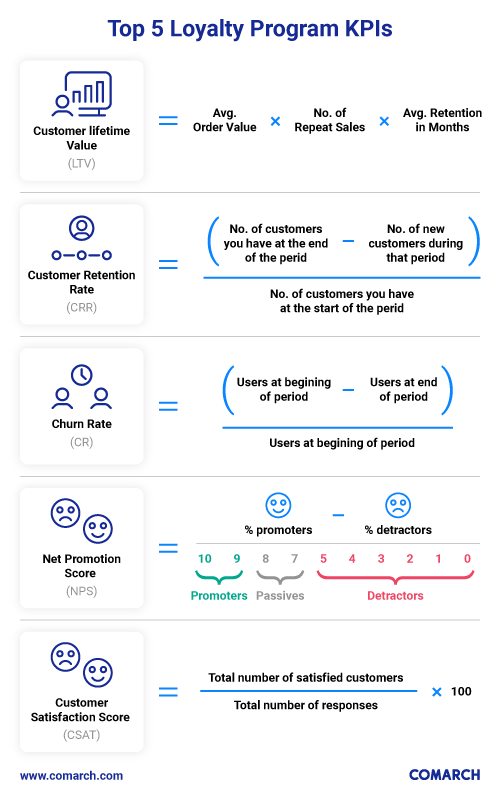
What are the Challenges of Building Customer Loyalty?
As you can see, building and cultivating customer loyalty can be very beneficial for your business. However, no one ready-to-use recipe will ensure you’ll do it successfully. Even with all the abovementioned ingredients, creating a solid base of loyal and engaged clients can be very difficult. Why?
Here are the key challenges you may come across while striving for customer loyalty:
- Problems with choosing/implementing the right technology.
- Lack of engagement.
- Building loyalty to discounts, not the brand.
- Focusing too much on monetary reward – not your brand mission and values shared with customers.
- Not considering the generational change – for example, 57% of Gen Z Americans are less loyal to brands now than before the COVID-19 pandemic and 80% are more willing to try out new brands.
- Lack of good monitoring software to tell you how your loyalty program is doing.
Modern customers can choose from a variety of brands and products. They constantly come across new ads and promotions, which makes them believe there’s always something better. They often jump from one loyalty program to another because of the rewards they can get during enrollment. A recent study says that the average American consumer belongs to more than 16 loyalty programs. The customer churn rate is now higher than ever – all it takes is one bad experience or even a negative review for a client to look elsewhere. That’s why investing in the most effective loyalty management system will help you overcome this challenge, and the obstacles listed above are so significant.
How Can Comarch Help
As a leader in the loyalty industry, Comarch can help you optimize your resources and start your journey toward customer loyalty. Our strategy and consulting experts will guide you in selecting the best techniques and technologies. Our cutting-edge customer loyalty solutions will provide you with all the features your business needs to stand out – including tiers, referrals, and rewards.
If you want to learn more about how Comarch’s loyalty management platform can grow your business, contact us today and start expanding your loyalty program!
Frequently Asked Questions
How can I use data to improve my loyalty program?
Data is a crucial tool for optimizing your loyalty program. By analyzing customer behavior and preferences, you can tailor rewards and promotions to their individual needs and interests. You can also use data to track program performance and identify areas for improvement.
Types of data that customer loyalty programs typically utilize include:
- Demographic data
- Transactional data
- Engagement data
- Social media data
- Survey and feedback data.
How can I ensure my loyalty program is compliant with data privacy regulations?
Compliance with data privacy regulations (such as GDPR or CCPA) is critical for any loyalty program. To ensure compliance, you should work with legal and data privacy experts to develop policies and procedures that align with relevant regulations. You should also provide clear information to customers about how their data will be collected, used, and protected.
How can I make my loyalty program stand out from the competition?
To make your loyalty program stand out, focus on creating a unique and memorable customer experience. This can include personalized rewards, special promotions, and exclusive access to events or products. Additionally, make sure your program is easy to use and understand, with clear instructions and a user-friendly interface.
What are the key features of a loyalty system that can handle many clients across different countries?
To provide your customers – regardless of their region and language preferences – with a truly seamless experience, a global loyalty system should distinguish itself with several key features that warrant scalability, customization, and efficiency. Here are some of the most important ones:
- Multilingual support.
- Scalable infrastructure to handle an increasing number of clients, transactions, and rewards.
- Security measures to prevent fraud and data breaches.
- Advanced data analytics and reporting capabilities to monitor program performance and optimize rewards and incentives continually.
How can a loyalty system help companies identify and target high-value customers based on their Customer Lifetime Value (CLV)?
A loyalty management system can track customers’ behaviors, spending habits, and program interactions to identify members with the highest CLV, indicating frequent purchases or significant spending. That way, you can offer those high-value clients exclusive benefits, such as early access to products and services or personalized offers, fostering their ongoing loyalty. The right software can also provide insights into the preferences of high-value members, enabling you to develop strategies explicitly tailored to their needs.
How can AI help improve your loyalty program?
AI tools can improve loyalty programs by providing personalized recommendations, predictive analytics, and marketing automation. We can use them to study customers’ data and habits for generating incentives that resonate with each of them individually. AI can also predict consumer behaviors (e.g., churn rates or purchase patterns) to recognize potential issues or opportunities for improving the program’s effectiveness. Moreover, artificial intelligence can automate management tasks – such as reward distribution, tracking, and fraud prevention – to save you time and resources.
You may be also interested in
- Guide: A Simple Guide to Loyalty Programs in Retail
- Guide: Discover the 10 Different Types of Loyalty Programs
- Infographic: Future Functionalities to Improve your Loyalty Program
- White paper: A Guide to Building Customer-Centric Loyalty Programs: 16 Actionable Strategies
- E-Book: How Loyalty Programs Boost Revenue
Tell Us Your Case 💬
Upcoming RFP? More info about product and services? Talk integrations? Need a price estimation?
Newsletter
Customer loyalty tips
straight to your inbox
Join the other 10 000 subscribers to start receiving:
 |  |  |
| Educational Materials | Inspiring Success Stories | Trending Event News |
Please wait
